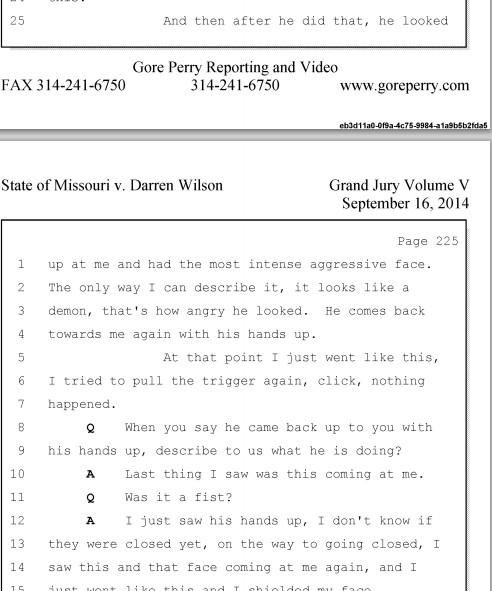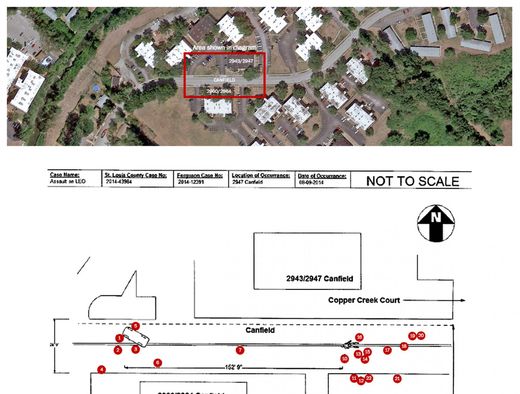Unorthodox police procedures come to light in grand jury documents
When Ferguson, Mo., police officer Darren Wilson left the scene of the fatal shooting of unarmed teenager Michael Brown, the officer returned to the police station unescorted, washed blood off his hands and placed his recently fired pistol into an evidence bag himself.
Those actions, described in grand jury testimony, violated protocols for handling a crime scene and securing evidence, according to experts in policing procedures and Justice Department documents.
Wilson's movements after the shooting were among a number of police actions in the aftermath of Brown's death that experts said were unusual. The grand jury transcripts revealed, for example, that the officers who interviewed Wilson immediately after the shooting did not tape the conversations. The transcripts also showed that an investigator from the medical examiner's office opted not to take measurements at the crime scene and arrived there believing that what happened between Brown and Wilson was "self-explanatory.''
It is unclear how these unorthodox practices may have influenced the investigation of a shooting that has triggered a national conversation about race and police practices. The grand jury's decision Monday not to indict Wilson in connection with the shooting death has led to protests nationwide.
Police and forensic officials have not responded to requests for comment over a two-day period.
For the fascinating read of the full testimony, click here.
In the critical first minutes after a shooting, investigators are trained to follow a time-tested process of protecting the scene to ensure that evidence is not compromised, according to the experts and documents. A shooting suspect - even a police officer - must be cordoned off in a controlled area and stripped of his clothing, his weapon secured by investigators, and must be escorted by officers if he leaves.
"An officer driving himself back? Wrong. An officer booking his own gun into evidence? Wrong," said David Klinger, an expert on police shootings with the University of Missouri at St. Louis who is also a former police officer. "The appropriate investigative procedures were not followed.''
A 2013 Justice Department manual on processing crime scenes, designed in conjunction with police departments across the country, addresses what experts said was perhaps the most serious breach of protocol after Brown was killed: Wilson washing the blood off his hands.
In wording that is underlined for emphasis, the manual says: "Do not allow suspect to use bathroom facilities, or to alter his/her appearance, including brushing hair or washing hands.''
The manual spells out in detail how to handle evidence and adhere to what is known as the chain of custody, a meticulous preservation of evidence until it is presented in court. Among the most important aspects, the manual said: securing the crime scene with "minimal contamination,'' confiscating the weapon and collecting the suspect's clothing while keeping him in a controlled location at the scene.
Chuck Drago, a former Florida police chief who runs a consulting firm that deals with police practices, described Wilson's actions in the aftermath of the shooting - especially washing the blood off his hands and handling his own gun - as "totally unorthodox and unusual. This would be considered very out of line - very, very bad from an investigative perspective.''
Drago said investigators are supposed to immediately seize a suspect's weapon, even that of an officer, and not allow a suspect to clean himself up. "They need to make sure he doesn't wipe off any evidence, destroy any evidence or who knows what,'' Drago said.
To view the graphic on evidence, click here.
Drago added that the failure to record interviews with investigators and the lack of measurements at the crime scene also are unusual. The FBI had a controversial policy for years of not taping witness interviews, but Drago said that most police departments have been recording interviews for at least two decades.
Mike Zopf, a lawyer and former police training specialist at the University of Illinois at Urbana-Champaign, said Wilson might have failed to follow proper procedure because it was the first time he fired his weapon. "There may have been a little bit of shock going on," Zopf said. "Even in the most justifiable shooting, there's a trauma that's unfamiliar to the human brain.''
Jim Towey, one of Wilson's attorneys, said his client was being careful under the circumstances, taking care to package his weapon in an evidence bag and washing off blood, which was getting sticky and uncomfortable.
"He drove himself back to the station because other [officers] were going to the scene. He realized that he had blood on him. It was getting sticky and it was gross and he didn't know if it was his or Brown's," Towey said. He added: "He immediately packaged his weapon from his possession. He did it himself because there was no one back at the station to do it for him, to the best of my recollection."
Towey said that although initial interviews with Wilson were not taped, an initial statement was put in writing and other interviews were taped.
The grand jury transcripts also described actions by others in law enforcement that experts considered unusual. An investigator with the St. Louis County medical examiner's office testified that he chose not to take measurements at the scene because when he arrived, "it was self-explanatory what happened. Somebody shot somebody. There was no question as to any distances or anything of that nature at the time I was there." (The voluminous documents released Monday show that at some point authorities did take measurements.)
According to the transcripts, the investigator, who was not identified but was described as a 25-year veteran, did not take his own photographs at the scene of the shooting because, he said, his camera's battery was dead. Instead, he relied on photographs taken by the St. Louis County police.
When Wilson returned to the police department after the shooting, no one prevented him from driving himself. No one photographed his bloodied hands before he washed up at the station because "there was no photographer available," an investigator quoted in the transcript said.
An FBI agent interviewed by the grand jury said he did record his interview with Wilson. The agent, who was not identified, said Wilson washed up immediately after the shooting because he was worried about the danger presented by someone else's blood, not about preserving evidence.
"His concern was not of evidence, but as a biohazard or what possible blood hazards it might attract," said the agent, who like other witnesses was not identified.
In the extended interviews, prosecutors questioned police procedures on a couple of occasions, including the decisions by Ferguson and St. Louis County investigators not to tape their initial interviews with the officer after the shooting.
Why not tape these answers, a St. Louis County detective was asked. "It is just common practice that we do not," the detective said.
Prosecutors also asked why Wilson was permitted to handle evidence. "He had informed me that after he responded to the police station, he had packaged his weapon and then he directed my attention to an evidence envelope,'' a St. Louis County detective said. Is it customary for the person who was involved in such an incident "to handle and package their own gun as evidence," the detective was asked.
Not according to the rules of the St. Louis County Police Department, the detective said. But Ferguson may have had its own rules, the detective said. He was not aware of "any policies or procedures they have in place" on the topic, and Ferguson officials have declined to address the subject.
Despite Wilson's unorthodox practices, transcripts appear to show that prosecutors treated him with greater deference than they showed some other grand jury witnesses.
Prosecutors, who led the inquiry, regularly grilled witnesses, testing their memories and going to great lengths to discredit some.
But in questioning Wilson, prosecutors were far more gentle and at times seemed to be guiding his answers.
At one point, a prosecutor asks Wilson: "So you got out of the car, you are running, you are telling [Brown] to stop; is that right?
"Correct,'' Wilson responds.
"And he's not listening?'' the prosecutor asks.
"No,'' Wilson says.
At another point, a prosecutor tells Wilson that she doesn't want to "put words in your mouth" even while asking that, as Brown was allegedly striking the officer in the face as he sat in his police car, "it was your opinion that you needed to pull out your weapon?''
"I felt another one of those punches in my face could knock me out or worse,'' Wilson testified. "I mean, it was, he's obviously bigger than I was and stronger and I've already taken two to the face and . . . the third one could be fatal if it hit me right.''




0 reacties:
Post a Comment